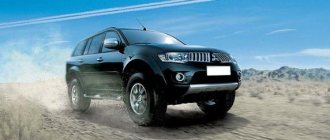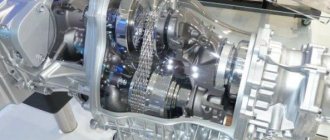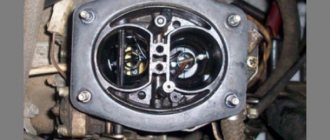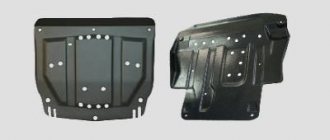Motors
The earliest cars were equipped with 4-cylinder engines of the 4G64 series, which were installed in passenger cars. In most cases, Pajero 1 was equipped with 3-liter 6-cylinder engines of the 6G72 series, the power of which is 177 hp. s., and there was also a 2.5-liter diesel engine - 4D56 whose power varied from 99 to 136 hp. With.
In Russia you can most often find a 3-liter V6. There are no complaints about this motor; it is reliable thanks to the cast iron block. The engine is high-torque, but it needs to be used once every 90,000 km. change the timing belt.
Over time, the motor control system may malfunction, but it can be repaired for little money. But more often spark plugs, lambda sensors, temperature sensors, and high-voltage wires can create problems. But if you keep track of all this and periodically replace it, then there will be no problems.
You also need to check whether the cooling system is in order and whether there are any fluid leaks. It happens that the fan may fail. And the radiators are rather weak; if the pressure in the system increases, they can swell a little, and they also quickly become dirty. Therefore, they have to be cleaned.
The car doesn’t consume much oil anymore; after 300,000 miles it can consume 0.5 liters per 1000 km. To reduce oil consumption, you can change the valve stem seals. By the way, this is not a lot of oil consumption when compared with some German cars. The engine still, despite the increased oil consumption, continues to work and even the catalysts can easily withstand it.
As with any car, you need to check the oil level and keep it normal, then there will be no problems with the crankshaft and the engine as a whole. For this engine, you need to fill in oil with a viscosity of SAE40. And if the car has already driven 200,000 km, then it is necessary to check the hydraulic compensators and hydraulic timing tensioners. You also need to check whether the intake manifold is sealed. The spark plugs should be in order and so should the high voltage wires. If there are problems with ignition, this will quickly damage the catalysts, which will lead to problems in the pistons, so you need to change the spark plugs on time.
You also need to monitor the condition of the gaskets on the front cylinder block cover to avoid oil leaks, which will accelerate the wear of the timing belt. It easily serves 90,000 km, but the safety margin is enough for 120,000 km. And if it is in oil, it will fail much earlier. A gasoline engine is considered more reliable than a diesel engine.
The design of the diesel engine is already outdated, if previously it had a power of 70 hp. s., then they began to boost it to 99 and 136 hp. With. And it cannot withstand loads, although it is of high quality. If you drive quietly, the engine can last 400,000 km. And if you just drive at a speed of 130 km/h for several hours, this can lead to cracks in the cylinder head, and the pressure in the cooling system will also increase.
On first-generation Pajero Sport diesel engines, the injection system usually does not cause problems, and if malfunctions do occur, they can be easily eliminated, the price of spare parts for the injection system is not high, and the injectors are inexpensive. But this applies to cars with low power. But on later diesel models with a power of 136 hp. With. everything will cost more, and the fuel system is different, the reliability is much lower.
In addition to the standard problems of diesel engines, there is a high probability of the fuel injection pump becoming airborne if the fuel system has become leaky. Also, over time, the fuel tank becomes dirty, which can interfere with the fuel supply. The main feature of this engine is that it does not have hydraulic compensators.
The valve drive does not have a particularly good design, so with age the gap becomes smaller, this leads to an increase in the temperature of the engine and the valves can crack, so to avoid problems, it is necessary every 50,000 km. check gaps and adjust them if necessary. During repairs, many are faced with the fact that the intercooler is located in the upper part, which makes servicing the car inconvenient.
The base engines have quite little power, which leads to the need to over-throttle in order for the car to accelerate faster. Those who do not have enough power do chip tuning using a wastegate, and the power increases to 150 hp. With. without changes in the firmware of the motor control unit. True, there will be more smoke from the exhaust pipe, and cracks may also appear in the cylinder head. It is advisable to install EGT sensors to monitor the outlet temperature.
Apart from the 2.5-liter diesel engine, there is no other diesel engine; there is a 2.8 diesel engine in nature, but it is so rare that it cannot be found on the secondary market. Although it is stronger than the 2.5-liter and more powerful. But for those who don't want gasoline, they'll have to put up with the diesel's low power. Moreover, the 1st generation Pajero Sport is not a car for racing, but rather an old workhorse for fishing or hunting trips.
Mitsubishi Pajero Sport
Mitsubishi Pajero Sport (Mitsubishi Pajero Sport)
Story
The year 1998 became a landmark year for Mitsubishi: a model that expanded the company’s SUV family, the Pajero, entered the assembly line. It became the mid-size SUV Pajero Sport, which, however, is indirectly related to the founder of this family. After all, the car was built on the platform of the second-generation L200 pickup truck and had all the technical features inherent in this model: a ladder frame structure, leaf spring suspension, rear-wheel drive or all-wheel drive. But in terms of exterior and interior design, these cars differed, since the SUV was a more luxurious class, with sporty features, which, in fact, was reflected in its name. The development of this model started in 1994, and a year later test prototypes were ready, which underwent road tests in Japan, the USA and South Africa.
The presentation of the first generation Mitsubishi Pajero Sport took place in 1996 at the Detroit Auto Show. Serial production of the car was launched at the Mitsubishi plant in the Japanese city of Nagoya.
Despite its sporty appearance, the passengers of this car did not experience much comfort when traveling on the roads. In 1999, Mitsubishi management decided to modernize the technical “stuffing” of the SUV in order to make it suitable for driving not only off-road.
In 2000, a restyled version of the Pajero Sport was presented at the Paris Motor Show. In addition to minor cosmetic changes to the exterior (radiator grille, front and rear bumpers, headlights and taillights) and interior (new instrument panel, improved interior materials and seats), there have been major changes to the car's chassis. Thus, the spring rear suspension was replaced by a dependent spring suspension with a torsion beam. This innovation had a positive effect on the car's handling in normal road conditions, and the comfort of rear-row passengers when driving off-road.
In 2005, another global restyling of the first generation of the model took place: it received a signature recognizable radiator grille, created from two trapezoidal elements, between which the Mitsubishi brand emblem is placed in a kind of triangle.
The body itself has become more streamlined, which has a positive effect on the aerodynamic characteristics of the car. The first generation Pajero Sport was equipped with two petrol (3.0 and 3.5 liter) and three diesel (2.5, 2.8 and 3.2 liter) engines, which were paired with a 5-speed manual or 4 or 5-speed automatic transmission.
The car was also equipped with an Easy Select 4WD all-wheel drive system, which was controlled using a transfer case. The driver at speeds of up to 100 km/h could choose one of two drive modes.
The first generation of this SUV, in addition to Japan, was produced in China (since 2003) and Brazil (since 2006). In total, from 1996 to 2008, the company produced 621,688 copies of this model.
The second and last generation of the Mitsubishi Pajero Sport was officially presented at the Moscow International Motor Show in 2008. In addition to Japan, production of the model was established in Thailand, Brazil, Bangladesh and the Philippines. From 2013, the SUV will be assembled in Russia.
Exterior
The second generation Pajero Sport borrowed exterior features from its technical “donor” - the fourth generation L200 pickup truck. Like the pickup truck, the SUV has an original radiator grille, in which three stylistic elements can be distinguished - two parallelograms, each of which is divided in a vertical plane by five chrome “ribs”. And in the center of the grille stands out an isosceles triangle, which contains “three diamonds” - the Mitsubishi emblem.
However, there is another design option for the radiator grille, in which the parallelograms are devoid of vertical “ribs” and are simply covered with a coarse mesh. The car's headlights are rectangular, with a small recess at the lower inner edge, and are equipped with halogen or xenon (depending on the configuration) optics. The massive front bumper has a large central air intake, U-shaped. Round fog lights are placed in the cone-shaped side niches of the bumper. The lower part of the bumper is covered with a silver body kit. The hood of the model is flat, with barely noticeable stampings in the center and on the sides.
Compared to the previous generation, the car has acquired a more streamlined body shape. Narrow A-pillars flow smoothly into a high roof, which is limited at the rear by medium-wide C-pillars set at an angle of 45 degrees. There are longitudinal rails on the roof.
The car's profile features athletic wheel arches and large side mirrors that make it easier to see rearward from the driver's seat. The flat side door panels are protected by narrow moldings that are painted to match the body color. Optionally, the car can be equipped with a steel running board.
At the rear of the car, the rear lights are located in a horizontal plane. They consist of two stylistic “triangles”, the larger of which is located on the rear fender, and the smaller on the tailgate. The tailgate is large, opens upward, and has a low loading height, making loading easy. The rear bumper is massive, with a fog lamp and a reversing light located in its side niches. The bottom of the bumper is protected by a body kit painted black.
Interior
The interior of the second generation Mitsubishi Pajero Sport is made in dark colors traditional for the brand's style. The car received a new dashboard, which is covered with a spherical visor. The central place on it is occupied by a large speedometer, on both sides it is supported by the “rounds” of the tachometer and the sensors of the remaining fuel in the tank and the coolant temperature combined into one formation. At the bottom of the speedometer there is a small on-board computer screen. The steering wheel of the model has a rim of medium thickness, three-spoke. On the side spokes there are remote control keys for the radio and cruise control.
The center console is rectangular, limited on the sides by plastic elements painted silver. At the top of the console there is a seven-inch touch screen multimedia system. Below it are three round control knobs for the car’s climate system. The lower part of the console is occupied by a deep rectangular niche for small items. The wide central tunnel houses the gearbox and transfer case selectors, and behind them are a pair of cup holders and shallow niches for small items. Between the front seats there is a wide armrest with a container.
The driver and front passenger seats have wide cushions and backrests and are equipped with pronounced lateral and lumbar support. The back of the rear sofa is divided in a 40/60 proportion, and the seat is stylistically divided into two seats.
Specifications
The second generation Mitsubishi Pajero Sport is still built on the L200 pickup platform. Its wheelbase is 2800 mm. The length of the body is 4695 mm, width – 1815 mm, and height – 1800 mm.
The Pajero Sport is equipped with two petrol and two diesel engines. Gasoline engines are represented by units of 3.0 (power 220 hp) and 3.5 (power 186 hp) liters. Diesel engines of 2.5 and 3.2 liters develop power of 178 and 163 horsepower, respectively. Power plants are equipped with a 5-speed manual or automatic transmission. The car is also equipped with a second-generation Super Select 4WD all-wheel drive system.
The car's drive is rear/all-wheel drive.
More details
Transmission
The Pajero Sport 1 uses a classic transmission, a transfer case, and all-wheel drive. But there are versions only with rear-wheel drive, this also comes with an automatic transmission and a 3-liter engine. This transmission does not cause problems. In all-wheel drive vehicles, the transfer case is attached to the automatic transmission housing, so it becomes a single unit. There are several distribution options.
Let's start with the usual 4WD, which has a rigid connection of the front axle and an automatic pneumatic drive of the hubs. This transfer case is the most common on left-hand drive cars. There are a lot of these cars left in America; they were produced until 2002. And on European versions, this transfer case was installed on cars produced before 2008.
There is a rear-wheel drive mode 2H, an all-wheel drive mode when the front axle is rigidly connected - 4H, and there is also a 4L mode - low gears with a gear ratio of 1.9. The main problems are considered to be: the drive chain stretches out after some time, the bearings hum and the pneumatics malfunction.
Pneumatic valves and sensors require the owner of such a car to constantly take care of cleaning and purging these components. The all-wheel drive light flashes very often on older copies. The cost of repair is not very high, it’s just that the service center doesn’t really want to look for the cause of the breakdown and replaces the entire assembly, but in fact it’s not difficult to find a problem in a unit with 2 solenoids and a vacuum tank. And there are almost no problems with the actuator.
There is also an unpleasant case with this transmission when the bushing of the gearbox control lever in the automatic transmission wears out, because it is not at all durable, but you can replace it inexpensively. This problem also occurs on a manual transmission.
It happens, but very rarely, that there is a real SuperSelect all-wheel drive, which is installed on the 1st generation; such a system is usually installed on the 2nd generation Pajero. If it happens on the 1st generation, it is on copies imported from Japan, and even less often on American and European cars.
This system is more complex; it has a full-fledged center differential with locking. In addition to the simple rear-wheel drive mode 2H, there is also 4H - all-wheel drive with a center differential, and low gears - 4L. And the mode when you can block the center differential is called 4Lc.
Also, many cars have factory forced pneumatic locking of the rear cross-axle differential. Here everything is much more complicated: electrics, pneumatics and the mechanical part of the transfer case. But still, this is a rare version of the 1st generation Pajero Sport, so it’s better not to bother with it; repairing it if it breaks will be difficult and expensive.
Model history
The car was put into production in 1996, and the car began to go on sale in other countries in 1997. In different countries, Mitsubishi Pajero Sport 1 is sold under different names. As a rule, this is due to different understandings of the same words in languages. In the Philippines, the Pajero Sport is sold as the Mitsubishi Challenger and Montero Sport, and in the UK as the Shogun Sport. Find out from the article “Why is Pajero called Montero or Shogun?” reasons for the different names.
Mitsubishi Pajero Sport 1 was developed based on the second generation Pajero. From him, the new SUV got an independent suspension and a solid rear axle. During the production of the car, several restylings were released, thanks to which, over time, the rear springs were replaced by springs.
Pajero Sport 1 was an alternative to the Mitsubishi Pajero because it was lower in price. Because of this, it was very popular, which convinced the Japanese to mass produce the model in different countries. In China, the Mitsubishi plant began operating in 2003, in the USA in 2004, and in Europe in 2008. The version with a 3-liter V6 petrol engine has gained the most popularity. Europeans liked diesel power units more.
Exterior Pajero Sport
It was he who became one of the important components of the model’s success. It was quite difficult to develop a body that would be both off-road and sporty. In short, the following external indicators worked on the image of the Mitsubishi Pajero Sport 1:
- Large wheels;
- Impressive ground clearance;
- Narrow but elongated body;
- Wide footrests;
- Spoiler on top of tailgate;
Model interior
Inside, the car is very reminiscent of the Mitsubishi L200 1986, which was taken as the basis for the development of the new model. The interior was designed in accordance with the time when the model was produced - the nineties. There were rare colored wood inserts, because the car bore the imprint of the American style inherent in SUVs. If we compare Mitsubishi interiors of that time, we can say that the Pajero Sport 1 was made quite well, although visually it may seem that the interior is cramped.
The driver's seat is organized quite simply and conveniently. A total of 2 selectors have been added:
- Gear shift;
- Climate control unit;
A strong imprint of American style can be seen in the leather seats. It is more comfortable to sit, there is a good distance to the pedals. The only negative is that the edge of the casing hangs over the pedals, which is why you need to be careful when braking sharply.
It is worth noting the high level of sound insulation and another great advantage of the Pajero Sport - a convenient trunk. It provides the ability to stretch curtains, niches for small items and hooks on which you can hang something. The rear seats can be folded down, thereby increasing the size of the trunk, making it an excellent sleeping place.
Handling of a sports Pajero
At the time of production, the model was very controllable, but if its performance is compared with modern realities, then the steering with a worm gear mechanism cannot be responsive. Despite this, the engineers made sure that the correctly selected gear allows you to feel confident behind the wheel. The car's handling is enough to easily change lanes in traffic jams without changing gears.
Engine Mitsubishi Pajero Sport 1
The most popular power unit of the first generation Pajero Sport was a 3-liter six-cylinder petrol engine. He is unpretentious, has a small appetite and can drive on 92 gasoline. The turbodiesel engine used in the first generation Pajero Wagon also received good recommendations. It was a little weak, but for budget-conscious motorists it was the most suitable option due to its unpretentiousness to fuel quality.
Transmission Pajero Sport
The front axle worked on the same principle as the L200 and Pajero II. This scheme did not allow the use of all-wheel drive when the wheels were slipping, namely on asphalt. This name has become a household name and began to characterize the full-fledged transmission of an SUV.
Suspension Pajero Sport 1
The suspension was also taken from the second generation Pajero. It was characterized by the following parameters:
- Suitable for fast movement on asphalt;
- Reliable off-road driving due to the massiveness and simplicity of the parts;
Good ground clearance made it possible to avoid problem areas on the road, no matter what it might be: snow ruts, rocks, dirt roads. It was possible to overcome a variety of obstacles even without low gears.
Tuning
Many owners of the 1st generation Pajero Sport install a more advanced transmission with part-time, now you can find many of these transfer cases on disassembly sites, they are called SS. To install such a transfer case on a car with a manual transmission, you will have to make a driveshaft, the length of which will be 1020 mm. along the axes of the crosses. But some craftsmen manage to install the front driveshaft from the version with an automatic transmission; its length is 1032 mm. In addition, the transfer case is fully compatible with the 2nd generation Pajero with a 2.5-liter diesel engine.
You can also install “super select” on cars with an automatic transmission. To do this, you need to install a transfer case from Pajero 2 after restyling with 2.8, 3.0 or 3.5 engines. And driveshafts from Pajero Sport AWD after restyling.
On cars produced after 2002, they began to install permanent AWD all-wheel drive with a silicone clutch, which provides soft automatic differential locking.
Cars for the American market after 2003 were produced only with this transmission. In America, the name Pajero Sport was replaced by Montero Sport. They do not have a forced locking of the center differential, but in fact these cars are no worse in terms of cross-country ability than versions with 4WD and SS. But on very serious off-road conditions, the difference in favor of AWD is slightly noticeable.
This transmission is also reliable if driven wisely. Approximately 180,000 km. serves as a leaf chain. And if you occasionally change the oil in the transfer case, then the entire mechanical part will last even longer. Typically, the front CV joint, driveshafts, silent blocks of transfer cases and axles can cause problems for their owners. You also need to monitor the system that controls all-wheel drive. When purchasing, be sure to pay attention to these nodes.
It is better to take a car with a manual transmission, because there are almost no problems with it. True, sometimes you will have to change the clutch and dual-mass flywheels on diesel versions. By the way, the automatic transmission of the V4A51 series and the rarer 5-speed V5A51, which is found on 3.5-liter American cars, are the most successful and reliable gearboxes.
Mileage 200,000 km. without any problems, there are even cases when such automatic transmissions last 400,000 km. served without repair. It all depends on how the car is used. If you operate the machine harshly, the rotation speed sensors may fail. Friction clutches also last at least 200,000 km, which is significantly more than on modern automatic transmissions. So, the design was reliable.
Cars sold on the Asian market are equipped with a 4-speed Aisin 30-43LE automatic transmission, which was installed in the famous Toyota Land Cruiser of different years of production. This gearbox is also reliable and more unpretentious, and if you use it carefully, it will last 500,000 km. The sky's the limit for her.
In the end, which package is better to buy?
It is better to buy a car that has been driven around the city most of the time, then its suspension will be more intact. It is better to take a car with a gasoline engine, it is more reliable, so it will not require repair costs, the main thing is to just change the oil and timing belt on time. There may be problems with the transmission and they will require quite a lot of money to fix.
Those who plan to drive most of the time around the city or on a normal road, it is better to take a car with permanent all-wheel drive AWD, it has the same handling as a passenger car - these are cars from the American market produced after 2003.
You can also take the version with part-time 4WD, then fuel consumption will be slightly lower if you drive only with rear wheel drive. But all-wheel drive gives you more confidence on slippery roads. You can also take cars with a smart Super Select transmission; the system will, if necessary, disable front-wheel drive, and on a slippery road or on sand it will turn on all-wheel drive, and you will have the feeling of a real SUV.
You can also read on this topic:
The Japanese have announced prices for the American version of the new generation Nissan Armada
Tuning Renault Sandero and some modifications on your own
Car polishing machines and how they work
The best American car brands today
Used second generation Nissan X-Trail on the secondary market
Share on social networks
Alexander Stepanoff November 2, 2016
Posted in: Japanese cars
Tags: used cars, Jeeps, Advice for motorists, Japanese cars











